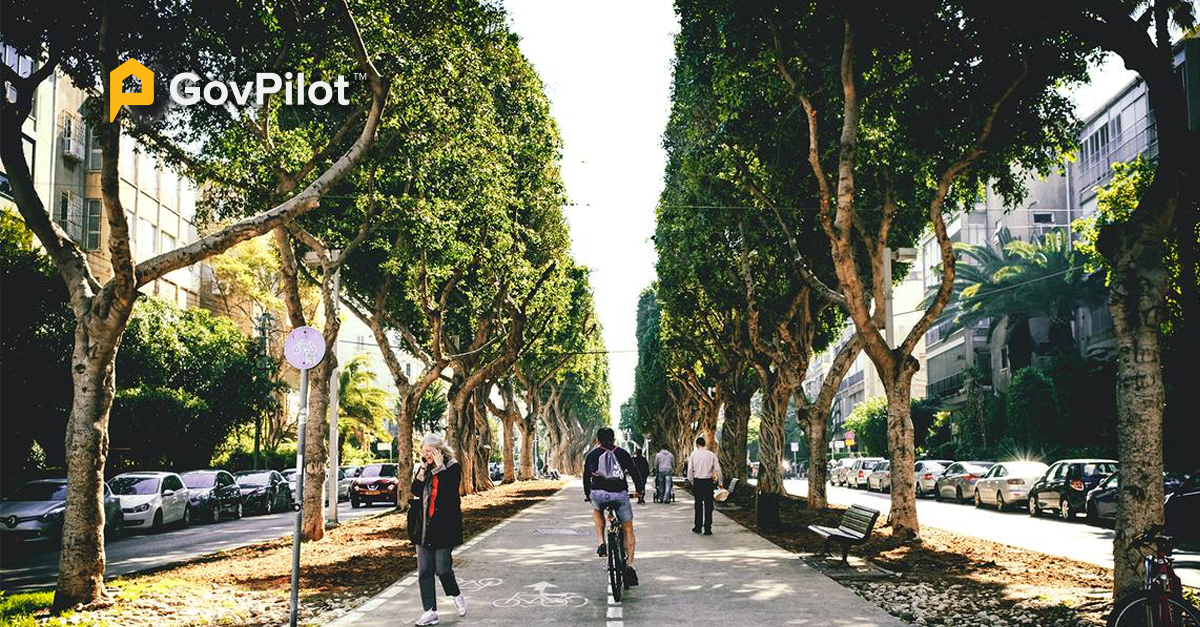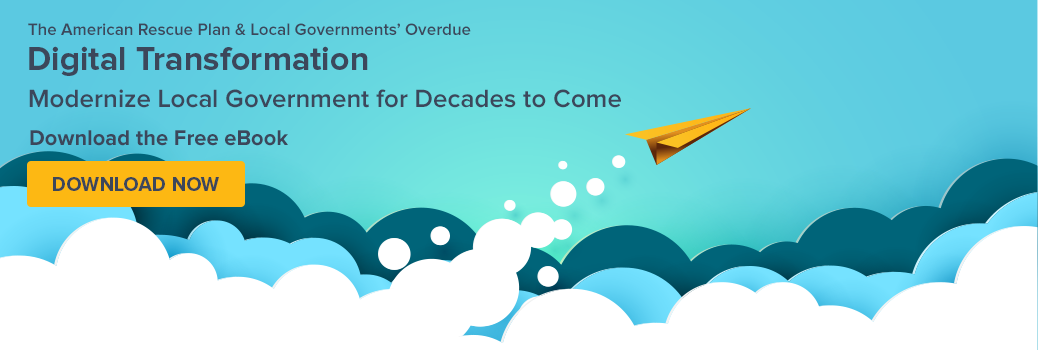When you think of major cities, which comes to mind: pedestrians or cars? Chances are, you’re probably thinking of a lot of people walking and maybe even a few opting to use a bicycle!
Yet, despite the fact that most people in major cities opt out of driving a motor vehicle, many are not designed for pedestrian mobility. That’s why the 15-minute city project aims to set cities down a road of urban transformation with convenient travel options and physical infrastructure that supports pedestrians and cyclists getting around in 15 minutes or less.
But what is a 15-minute city? And can your local government improve the local quality of life for citizens by embracing accessibility to amenities without a reliance on cars? Follow along to find out!
What is a 15-Minute City?
As the name implies, the concept of a 15 minute city is for communities to live, learn and thrive within a 15-minute neighborhood radius by foot or bike. This means that planning and zoning priorities should shift from making space for cars to replacing them by creating places for people traveling on foot or bike.
Initially, a number of cities, including Paris, France took charge of the 15 minute city concept. The mayor of Paris Anne Hidalgo said, “We need to reinvent the idea of urban proximity,” when she introduced the policy as a means to reduce the vehicular-footprint in the city back in 2013.
Now, cities around the world are taking on this digital transformation, with the goal of making human necessities more accessible to all community members, especially those without cars.
How to Best Design a 15-Minute City?
A notable blog and organization formed around the 15-minute city concept, known as the 15-Minute City Project, describes their objective to, “help access-focused urban transformations be what we need them to be: ambitious, inclusive, measurable, and effectively implemented.”
Municipal planners should consider the following questions when implementing a 15-minute city plan:
-
Do you have goals for your community in mind?
Any municipal project without proper urban planning is bound to be stressful and inefficient. Consider what infrastructure issues your city could improve on, which areas could benefit from more pedestrian zones, and how to plan to adapt with less cars on the road. You could even host public meetings and poll the community with your government social media accounts to gauge interest in what should be updated in your city to make it more convenient for constituent navigation.
-
Does the project consider everyone in your community?
Typically, residents in lower-income areas are the least likely to have cars. Urban planners should consider how community members of all wealth-levels will be impacted, and ensure that community members have equitable access to necessities such as public transport.
- Take it a step farther and learn more about how to make your community more equitable for all community members with improved access for the disabled and the elderly.
-
Do you have the proper government workflows in place?
If your municipal government doesn’t have good processes in place, your 15-minute city project will wind up being much more expensive and slow-moving. Consider making a government digital transformation a priority in order to automate processes, save time, and collect government data.
What Are the Benefits of Making Your Community a 15-Minute City?
There are many benefits to urban transformation. An urban transformation, as the name implies, should vastly improve upon your existing infrastructure to make people’s lives better.
Here’s how improving the access to necessities for constituents can positively impact your community:
1. Decreased Carbon Emissions
Reducing the amount of carbon emissions in your community is a win for everyone. Your city will actively take a stand against climate change, air quality will improve, constituents will be healthier, local businesses will thrive, and traffic congestion will decrease.
Learn more about How Governments Can Make Their Community More Sustainable.
2. More Businesses and Revenue
A 15-minute city plan not only focuses on improving walkways and bike lanes, but also on increasing access to basic human necessities like food, clothing, employment-opportunities, and home necessities in your municipality.
That means the opportunity is ripe for your municipal government to approve zoning permits for businesses old and new to establish an outdoor footprint and reach customers in areas with heavy foot traffic. More revenue for local businesses, higher employment rates, and additional tax revenue for your government to invest back into the city makes for a more desirable place to live and work.
Read on for tips about generating municipal revenue for your community and making the most out of your local government budget.
3. Healthier and Happier Constituents
More exercise via walking or cycling means that community members will improve their physical health and get more fresh air, both of which are attributed to a higher-quality of life and better mental health. When government officials and staff like yourself positively transform the city, improve quality of life, and reduce inequalities, constituents will be more satisfied and inclined to vote in your re-election campaign. Further it will improve residents' trust in local government as well as property values and desirability.
4. Collect Measurable Data
With government management software, you’ll be able to collect data on the overall 15-minute city urban transformation process. You can use it to streamline planning and zoning processes, track government workflows to ensure things like mobile inspections or online business registration are moving along smoothly, and analyze how it impacts constituents and local businesses to make future governmental decisions.
How Can Your City Implement a 15-Minute City Plan?
Federal funds from both the US Infrastructure Bill and the American Rescue Plan are specifically dedicated to improving neighborhood infrastructure in American cities. With ARPA funds, federal stimulus dollars will be put directly into your municipal government’s hands and gives you permission to prioritize physical and digital infrastructure initiatives. Within the US Infrastructure Bill, the Safe Streets for All and Vision Zero programs allow municipal governments to apply with urban zoning plans and, upon approval, receive infrastructure funds to improve pedestrian and bike zones.
Keep in mind, improving the capabilities for constituents to buy and businesses to sell necessities will mean the increase in revenue should eventually surpass the amount the project cost to implement!
To learn more about the American Rescue Plan Act and digital transformation, download GovPilot's comprehensive eBook on the subject.
Can Digital Infrastructure Help With Municipal Planning Projects Like 15-Minute Cities?
With GovPilot, your local government can save time with cloud-based software and automated workflows that will save your government workers time, collect valuable data, and improve the lives of constituents.
Digitization of government processes makes the biggest impact on transforming your local government, and helps to smooth the transition as your community becomes more convenient, and closer to becoming a 15-minute city.
Consider the following technology solutions from GovPilot to expedite the process of becoming a 15-Minute CIty:
- Building Permits: allow applicants to apply online for construction permits efficiently to speed up construction timelines.
- Planning Module: applicants can apply online for various types of city planning applications before the applications are automatically directed to the right department for review.
- GIS Mapping: creates 3D maps of your community to display data about the environment and make construction planning easier
- Vacant Property Registration: allows governments to review the registered vacant properties in the community and plan construction projects accordingly.
- Activity Registration: aims to simplify the event planning application process through digitization to manage activities that will bring foot traffic to your area.
To learn more, schedule a free 15-minute consultation.
15-Minute City FAQs
-
What are 15-Minute Cities?
15-Minute cities, coined by French professor Carlos Moreno, are a global phenomenon. Local governments around the world are focused on making a commute for any community member by foot no longer than a 15-minute walk. How this goal is implemented city by city varies drastically, depending on existing public transit infrastructure, the locations of residential facilities throughout the city, and the density of the city.
-
What Are Existing Examples of 15-Minute Cities?
Mayor Anne Hidalgo of Paris brought the concept of a 15-minute city to the forefront, but it has quickly taken off around the world. Global cities like Milan, Barcelona, Amsterdam, Madrid, and Ottawa have taken drastic measures to improve city life. American cities like Chicago, New York City, Detroit, Seattle, and Philadelphia are also actively taking action to improve designated zones for pedestrians and cyclists.
-
How Do 15-Minute Cities Affect Public Health?
15-Minute cities are designed to be traveled on foot, helping citizens naturally be more active in their day-to-day lives and get more steps in. These cities also cut back on motor-vehicle emissions which improves their air quality, and overall public health.
Check out these other GovPilot guides to improve your local government:
- What is Civic Engagement: Four Examples
- What is Disaster Resilient Infrastructure? Why is it Needed?
- Building Inspections 101: How Local Governments Can Ensure Public Safety
- Public Sector Recruiting: How to Hire Talented Government Workers
- Should the Public Sector Use Cloud or In-House Servers?
- Disaster Preparedness: How Local Governments Build Resilient Communities
- Government Cybersecurity: How to Prevent Ransomware Attacks
Sources:






